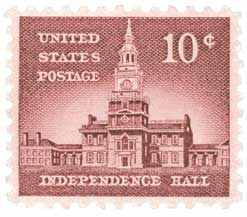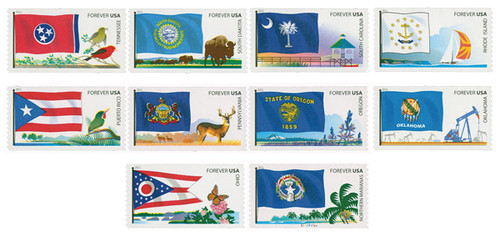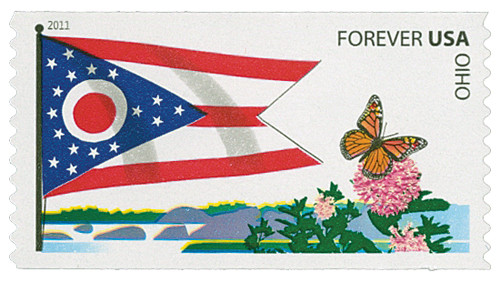
# 4317 - 2011 First-Class Forever Stamp - Flags of Our Nation: Pennsylvania
Â
City: Columbus, Ohio
Printed By: Sennett Security Products
Pennsylvania Becomes 2nd StateÂ

On December 12, 1787, Pennsylvania was the second state to ratify the Constitution and be admitted to the Union.
Two major Indian tribes lived in Pennsylvania when the first European explorers arrived – the Algonquian and the Iroquoian.  The Algonquian tribes included the Conoy, Delaware, Nanticoke, and Shawnee. Only one Iroquoian tribe lived in the region, the Susquehannock, who lived along the Susquehanna River.
Henry Hudson, an English explorer working for the Dutch East India Company, sailed into Delaware Bay looking for a trade route to the Far East. Hudson’s reports on the region led the Dutch to send more explorers, and in 1615, Cornelius Hendricksen sailed the Delaware up to what is now Philadelphia.
However, it was the Swedes who made the first permanent settlement in the region. In 1643, they made Tinicum Island, near Philadelphia, the capital of the colony of New Sweden. Dutch troops led by Peter Stuyvesant came from New Netherland and captured New Sweden in 1655. The Dutch controlled the region until 1664, when the English assumed control. The Duke of York governed until 1681, when King Charles II gave this land to William Penn to pay a debt he owed his father, an English admiral. Penn wanted to name the region New Wales, but was blocked by a powerful Welsh member of the Privy Council. So, Penn settled on the name Sylvania, which means woods. King James II added Penn to the name in honor of William’s father.

As a Quaker, William Penn wanted the people of Pennsylvania to have freedom to worship, as well as personal and political freedoms. He arrived in Pennsylvania in 1682 with the colony’s first constitution, the Frame of Government, which he had written. It provided for a deputy governor and an elected legislature with a provincial council and a general assembly. In 1683, the legislature drafted a second Frame of Government, which gave the people even more power. Shortly after he arrived, Penn paid the Indians in the region for the land King Charles had given him – even though he was not obligated to do so. Penn was removed as governor of the colony for a short time when his daughter, Mary, and her husband, William, overthrew his close friend King James II.

From the late 1600s until the mid-1700s, Pennsylvania, along with other British colonies, was involved in several wars against French colonists and their Indian allies. The French and Indian War started in western Pennsylvania in 1754. The war ended with a British victory in 1763. Later that year, Pontiac, an Ottawa chief, fought against the British. Ottawa lost the Battle of Bushy Run, near Greensburg. Pennsylvania bought more land from the Indians in the Fort Stanwix Treaty of 1768. This settled most of the colony’s Indian troubles.
Pennsylvania, and particularly Philadelphia, was a hotbed for revolutionary patriots. The First Continental Congress met in Philadelphia on September 5, 1774. This congress voted to stop all trade with Great Britain. The Revolutionary War began in April 1775. The next month, the Second Continental Congress met in Philadelphia. The delegates there voted for independence. This resulted in the adoption of the Declaration of Independence on July 4, 1776, in the Pennsylvania Statehouse (now Liberty Hall) in Philadelphia. The state’s first convention was held in the State House at that time.

During the war a great deal of fighting took place in Philadelphia, and the Continental Congress was twice forced to flee the city. As the war started to turn against the British, they withdrew from the city in June 1778, and the Continental Congress returned. During the winter of 1777 and 1778, George Washington and his army camped in Valley Forge, an area along the Schuylkill River, near Philadelphia. The troops had inadequate food, clothing, and shelter. Many perished. The legendary winter at Valley Forge tested the loyalty of the American army. On January 9, 1778, Pennsylvania adopted the forerunner to the U.S. Constitution, the Articles of Confederation. The Constitutional Convention met in Philadelphia from May to September in 1778. Pennsylvania became the second state to approve the U.S. Constitution and join the Union on December 12, 1787. Philadelphia served as the nation’s capital from 1790 until 1800, when it was moved to Washington, D.C.
Pennsylvania was known as a leader in the iron and grain milling industries as early as 1750. After the Revolutionary War, the state continued to modernize and increase its industrial growth. John Fitch demonstrated America’s first workable steamboat on the Delaware River near Philadelphia in 1787. Robert Fulton launched a steamboat in Pittsburgh in 1811. It was the first to travel the Ohio and Mississippi rivers. The first long canal in the U.S., the Schuykill Canal, was built between Philadelphia and Reading in 1825. The next year, the state started building the Pennsylvania Canal System. By 1834, Philadelphia and Pittsburgh were linked by canals and railroads. In 1859, Edwin Drake drilled the nation’s first commercially successful oil well near Titusville.

Pennsylvania was a leading center of the antislavery movement. Many Pennsylvanians supported the Underground Railroad, a system that helped slaves escape to freedom. The state sent 340,000 troops to fight in the Civil War – only New York sent more troops. Several raids led by Jeb Stuart and Wade Hampton were staged against Pennsylvania. One of the bloodiest battles in history, Gettysburg took place in southern Pennsylvania. This three-day struggle broke the strength of the Confederacy and was a major turning point in the war. On November 19, 1863, President Abraham Lincoln dedicated part of the Gettysburg cemetery to those that died there. At the dedication ceremonies he delivered his famous Gettysburg Address.
After the Civil War, Pennsylvania prospered. The state’s existing agricultural, lumber, and mining industries continued to grow. It also became a leading producer of oil, cement, electrical equipment, and aluminum. Pittsburgh became the nation’s leading producer of steel. This growth continued into the 1900s, stalled during the Great Depression, and then resumed with the start of World War II (1939-45).

During the 1970s and 1980s, foreign competition and other problems led to a decline of the state’s steel-making industry. Although it remains one of the nation’s leading steel producers, Pennsylvania began shifting from industrial and manufacturing activities to educational, financial, service, and technology-based industries. Larger cities like Philadelphia, Pittsburgh, and Allentown have led these economic changes.
Pennsylvania has also focused on restoring and preserving many of its historical sites and buildings, especially in Philadelphia and Pittsburgh. This work has increased tourism and created thousands of new jobs.
Â
City: Columbus, Ohio
Printed By: Sennett Security Products
Pennsylvania Becomes 2nd StateÂ

On December 12, 1787, Pennsylvania was the second state to ratify the Constitution and be admitted to the Union.
Two major Indian tribes lived in Pennsylvania when the first European explorers arrived – the Algonquian and the Iroquoian.  The Algonquian tribes included the Conoy, Delaware, Nanticoke, and Shawnee. Only one Iroquoian tribe lived in the region, the Susquehannock, who lived along the Susquehanna River.
Henry Hudson, an English explorer working for the Dutch East India Company, sailed into Delaware Bay looking for a trade route to the Far East. Hudson’s reports on the region led the Dutch to send more explorers, and in 1615, Cornelius Hendricksen sailed the Delaware up to what is now Philadelphia.
However, it was the Swedes who made the first permanent settlement in the region. In 1643, they made Tinicum Island, near Philadelphia, the capital of the colony of New Sweden. Dutch troops led by Peter Stuyvesant came from New Netherland and captured New Sweden in 1655. The Dutch controlled the region until 1664, when the English assumed control. The Duke of York governed until 1681, when King Charles II gave this land to William Penn to pay a debt he owed his father, an English admiral. Penn wanted to name the region New Wales, but was blocked by a powerful Welsh member of the Privy Council. So, Penn settled on the name Sylvania, which means woods. King James II added Penn to the name in honor of William’s father.

As a Quaker, William Penn wanted the people of Pennsylvania to have freedom to worship, as well as personal and political freedoms. He arrived in Pennsylvania in 1682 with the colony’s first constitution, the Frame of Government, which he had written. It provided for a deputy governor and an elected legislature with a provincial council and a general assembly. In 1683, the legislature drafted a second Frame of Government, which gave the people even more power. Shortly after he arrived, Penn paid the Indians in the region for the land King Charles had given him – even though he was not obligated to do so. Penn was removed as governor of the colony for a short time when his daughter, Mary, and her husband, William, overthrew his close friend King James II.

From the late 1600s until the mid-1700s, Pennsylvania, along with other British colonies, was involved in several wars against French colonists and their Indian allies. The French and Indian War started in western Pennsylvania in 1754. The war ended with a British victory in 1763. Later that year, Pontiac, an Ottawa chief, fought against the British. Ottawa lost the Battle of Bushy Run, near Greensburg. Pennsylvania bought more land from the Indians in the Fort Stanwix Treaty of 1768. This settled most of the colony’s Indian troubles.
Pennsylvania, and particularly Philadelphia, was a hotbed for revolutionary patriots. The First Continental Congress met in Philadelphia on September 5, 1774. This congress voted to stop all trade with Great Britain. The Revolutionary War began in April 1775. The next month, the Second Continental Congress met in Philadelphia. The delegates there voted for independence. This resulted in the adoption of the Declaration of Independence on July 4, 1776, in the Pennsylvania Statehouse (now Liberty Hall) in Philadelphia. The state’s first convention was held in the State House at that time.

During the war a great deal of fighting took place in Philadelphia, and the Continental Congress was twice forced to flee the city. As the war started to turn against the British, they withdrew from the city in June 1778, and the Continental Congress returned. During the winter of 1777 and 1778, George Washington and his army camped in Valley Forge, an area along the Schuylkill River, near Philadelphia. The troops had inadequate food, clothing, and shelter. Many perished. The legendary winter at Valley Forge tested the loyalty of the American army. On January 9, 1778, Pennsylvania adopted the forerunner to the U.S. Constitution, the Articles of Confederation. The Constitutional Convention met in Philadelphia from May to September in 1778. Pennsylvania became the second state to approve the U.S. Constitution and join the Union on December 12, 1787. Philadelphia served as the nation’s capital from 1790 until 1800, when it was moved to Washington, D.C.
Pennsylvania was known as a leader in the iron and grain milling industries as early as 1750. After the Revolutionary War, the state continued to modernize and increase its industrial growth. John Fitch demonstrated America’s first workable steamboat on the Delaware River near Philadelphia in 1787. Robert Fulton launched a steamboat in Pittsburgh in 1811. It was the first to travel the Ohio and Mississippi rivers. The first long canal in the U.S., the Schuykill Canal, was built between Philadelphia and Reading in 1825. The next year, the state started building the Pennsylvania Canal System. By 1834, Philadelphia and Pittsburgh were linked by canals and railroads. In 1859, Edwin Drake drilled the nation’s first commercially successful oil well near Titusville.

Pennsylvania was a leading center of the antislavery movement. Many Pennsylvanians supported the Underground Railroad, a system that helped slaves escape to freedom. The state sent 340,000 troops to fight in the Civil War – only New York sent more troops. Several raids led by Jeb Stuart and Wade Hampton were staged against Pennsylvania. One of the bloodiest battles in history, Gettysburg took place in southern Pennsylvania. This three-day struggle broke the strength of the Confederacy and was a major turning point in the war. On November 19, 1863, President Abraham Lincoln dedicated part of the Gettysburg cemetery to those that died there. At the dedication ceremonies he delivered his famous Gettysburg Address.
After the Civil War, Pennsylvania prospered. The state’s existing agricultural, lumber, and mining industries continued to grow. It also became a leading producer of oil, cement, electrical equipment, and aluminum. Pittsburgh became the nation’s leading producer of steel. This growth continued into the 1900s, stalled during the Great Depression, and then resumed with the start of World War II (1939-45).

During the 1970s and 1980s, foreign competition and other problems led to a decline of the state’s steel-making industry. Although it remains one of the nation’s leading steel producers, Pennsylvania began shifting from industrial and manufacturing activities to educational, financial, service, and technology-based industries. Larger cities like Philadelphia, Pittsburgh, and Allentown have led these economic changes.
Pennsylvania has also focused on restoring and preserving many of its historical sites and buildings, especially in Philadelphia and Pittsburgh. This work has increased tourism and created thousands of new jobs.















